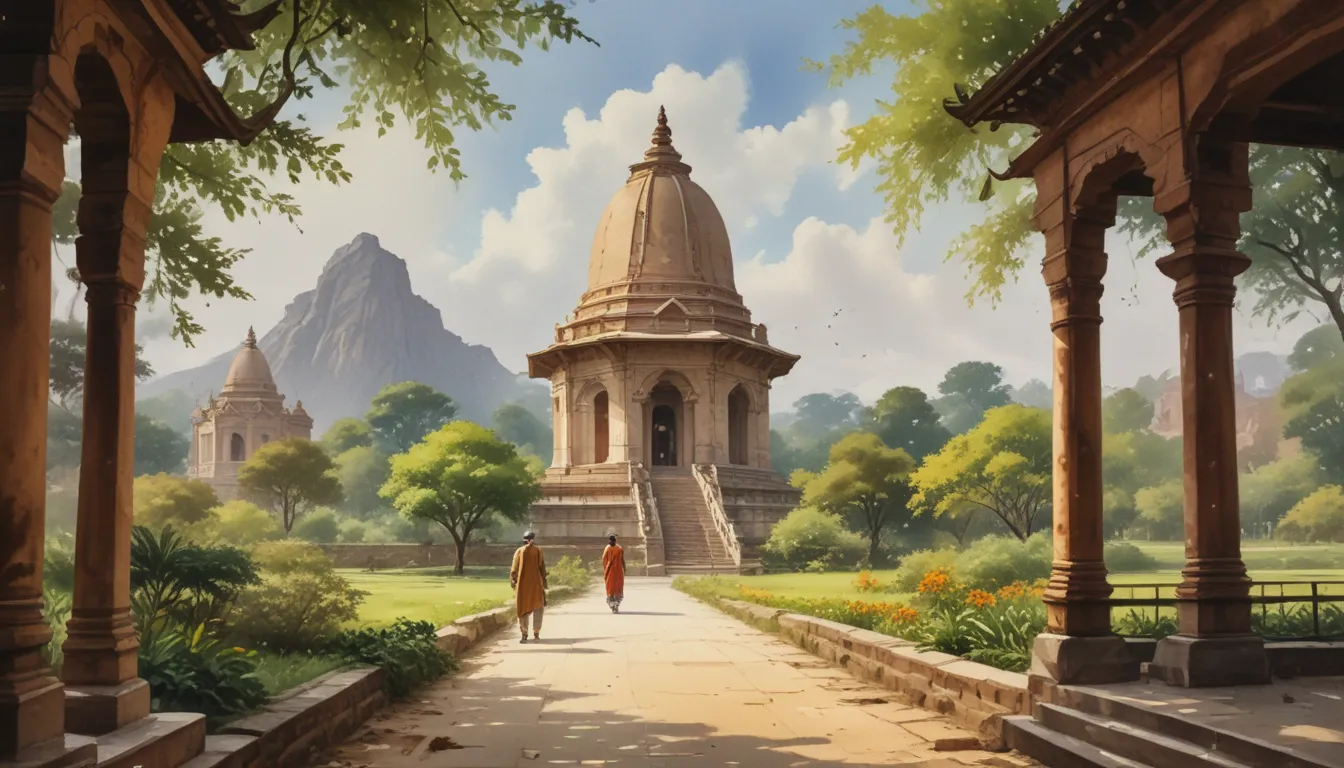The images in our articles are for illustrative purposes only and may not exactly match the content. They are intended to capture your interest and complement the text, not to replace it.
Are you ready to embark on a journey of discovery and enlightenment? Look no further than Sarnath, a small town nestled just outside Varanasi in India, that holds a profound significance in the hearts of Buddhists worldwide. This ancient Buddhist monastic complex serves as the birthplace of Buddhism, where Lord Buddha delivered his first sermon after attaining enlightenment. With its rich history, majestic stupas, and serene ambiance, Sarnath is a haven for pilgrims and spiritual seekers seeking to connect with the roots of Buddhism. In this article, we will delve into 19 extraordinary facts about Sarnath that will deepen your understanding of its historical and religious importance.
Unraveling the Mysteries of Sarnath
- Sarnath, a UNESCO World Heritage Site, boasts ancient monasteries, vibrant festivals, and a symbol of peace and enlightenment that draws pilgrims and history enthusiasts from around the globe.
- The Dhamek Stupa, Ashoka Pillar, and Mulagandhakuti Vihara stand as key attractions in Sarnath, showcasing its artistic heritage and pivotal role in spreading Buddhism across Asia.
The Birthplace of Buddhism
Sarnath, situated in Uttar Pradesh, India, holds immense significance in the Buddhist religion as the place where Lord Buddha delivered his first sermon, known as the Dhammacakkappavattana Sutta.
The Legend of “Lord of the Deer”
The name “Sarnath” derives from “sar” (deer) and “nath” (lord), reflecting a popular legend that Lord Buddha gave his first sermon in a deer park in Sarnath.
A Hub of Ancient Buddhist Monasteries
Over the centuries, Sarnath has been home to various Buddhist monasteries, serving as centers for the study and practice of Buddhist teachings and attracting monks and scholars from across the world.
Discovering the Magnificence of the Dhamek Stupa
The Dhamek Stupa, a towering cylindrical monument, is believed to mark the spot where Lord Buddha delivered his first sermon. Adorned with intricate carvings, it depicts scenes from the life of Lord Buddha.
The Ashoka Pillar: A Symbol of Peace
Commissioned by Emperor Ashoka, the Ashoka Pillar stands as a symbol of peace and non-violence, bearing the Edict of Ashoka that highlights his commitment to Buddhist principles.
Exploring the Richness of the Sarnath Museum
Home to a vast collection of Buddhist artifacts and relics, the Sarnath Museum offers a glimpse into the historical and cultural heritage of Sarnath through sculptures, statues, manuscripts, and inscriptions.
A Pilgrimage Site of Global Significance
With its deep-rooted historical and religious importance, Sarnath attracts pilgrims from around the world who come to pay homage to the birthplace of Buddhism and seek spiritual enlightenment.
Unveiling the Ancient Ruins of Sarnath
The archaeological site of Sarnath reveals the remnants of ancient monasteries, temples, and stupas, providing a glimpse into the flourishing Buddhist culture of yesteryears.
The Sacred Mulagandhakuti Vihara
The Mulagandhakuti Vihara, a sacred Buddhist shrine, is built at the site where Lord Buddha spent his first rainy season post-enlightenment. Housing a golden statue of Lord Buddha, it serves as a place of meditation and devotion.
Artistic Splendor of Sarnath
The art and architecture of Sarnath showcase a blend of ancient Indian styles through intricate carvings, exquisite sculptures, and beautiful frescoes that adorn the monastic complex.
Sarnath’s Role in the Spread of Buddhism
As the birthplace of Buddha’s teachings, Sarnath played a pivotal role in the dissemination of Buddhism across Asia, becoming a center for learning and the establishment of the Sangha.
The Sarnath International Nyingma Institute
Founded in 1976, the Sarnath International Nyingma Institute is dedicated to preserving and promoting Buddhist teachings through courses in Buddhist studies, meditation, and Tibetan language.
Vibrant Buddhist Festivals in Sarnath
Sarnath hosts various Buddhist festivals and celebrations, with Buddha Purnima being the most notable one, commemorating the birth, enlightenment, and passing away of Lord Buddha.
Embracing Cultural Diversity
Throughout its history, Sarnath has been a melting pot of cultures and traditions, fostering interactions between Buddhist monks, pilgrims, and scholars from diverse backgrounds.
The Mahabodhi Society of India: A Beacon of Buddhism
The Mahabodhi Society of India, headquartered in Sarnath, plays a significant role in promoting Buddhist education, social welfare, and interfaith dialogue, overlooking the serene town of Sarnath.
The Tranquil Oasis of Sarnath
Located a mere 10 kilometers from Varanasi, Sarnath offers a serene and tranquil environment, providing a peaceful respite from the bustling streets of nearby Varanasi.
A UNESCO World Heritage Site
Recognized for its cultural and historical significance, Sarnath was designated as a UNESCO World Heritage Site, ensuring its preservation and protection for generations to come.
An Abode of Peace and Enlightenment
The serenity and spiritual essence of Sarnath make it a symbol of peace and enlightenment, inspiring individuals from all walks of life to seek inner harmony and enlightenment.
A Sacred Destination for Pilgrims and Enthusiasts
Whether you are a devoted Buddhist or a curious history enthusiast, Sarnath offers a profound journey into the heart of Buddhism through its historical legacy, tranquil setting, and architectural wonders.
In Conclusion
Sarnath, the cradle of Buddhism, embodies deep historical and spiritual significance through its rich heritage and impact on Buddhism. From Buddha’s inaugural sermon to the array of ancient relics and stupas, Sarnath continues to captivate pilgrims and visitors worldwide.
The essence of Sarnath transcends physical structures, encapsulating the enlightened teachings and ideals of Buddhism. It beckons individuals to explore their transformative potential, seek inner peace, and embark on a journey of spiritual growth and enlightenment.
Visiting Sarnath promises an awe-inspiring experience, connecting travelers with Buddhism’s roots and profound philosophy. Whether you seek historical knowledge, spiritual enlightenment, or architectural marvels, Sarnath beckons you to immerse yourself in its extraordinary tapestry of history and spirituality.
FAQs
Q: When was Sarnath founded?
A: Sarnath was founded in the 3rd century BCE by Emperor Ashoka, a prominent Buddhist ruler.
Q: What is the significance of Sarnath in Buddhism?
A: Sarnath is considered one of the four holiest Buddhist sites as it is where Buddha delivered his first sermon after attaining enlightenment.
Q: Are there any ancient relics in Sarnath?
A: Yes, Sarnath houses a vast collection of ancient relics, including the Dhamek Stupa dating back to the 5th century BCE.
Q: What can I expect to see in Sarnath?
A: Sarnath offers a range of attractions, including ancient stupas, monasteries, museums, and the Ashoka Pillar with its edicts.
Q: Is Sarnath easily accessible for tourists?
A: Yes, Sarnath is well-connected by road and rail, located just a short distance from Varanasi, a major city in India.
Embark on a journey of discovery and enlightenment as you explore the wonders of Sarnath, a place where history, spirituality, and tranquility converge to create an extraordinary experience. Pack your bags and set forth on a pilgrimage to Sarnath, where the legacy of Buddhism awaits to inspire and enlighten your soul.






